24 Great Games to Improve Hand-Eye Coordination
Hand-eye coordination is the relationship between what we see and how we use our hands.
Some children on the Autistic Spectrum struggle with hand-eye coordination, which makes doing everyday tasks like getting dressed, using a pen or scissors, or catching a ball more difficult.
The good news is hand-eye coordination skills can be worked on and improved.
Playing with everyday objects is simplest way of doing this. Varying the size and shape of the object we offer our child means the child has to use different parts of the hand to manipulate it.
If our child has poor tactile registration (i.e. they do not always notice an object in their hands), we can add a sensory component by using textured toys such as pop toobs.
Here are some more ideas for improving hand-eye coordination. The preparation steps can really help!
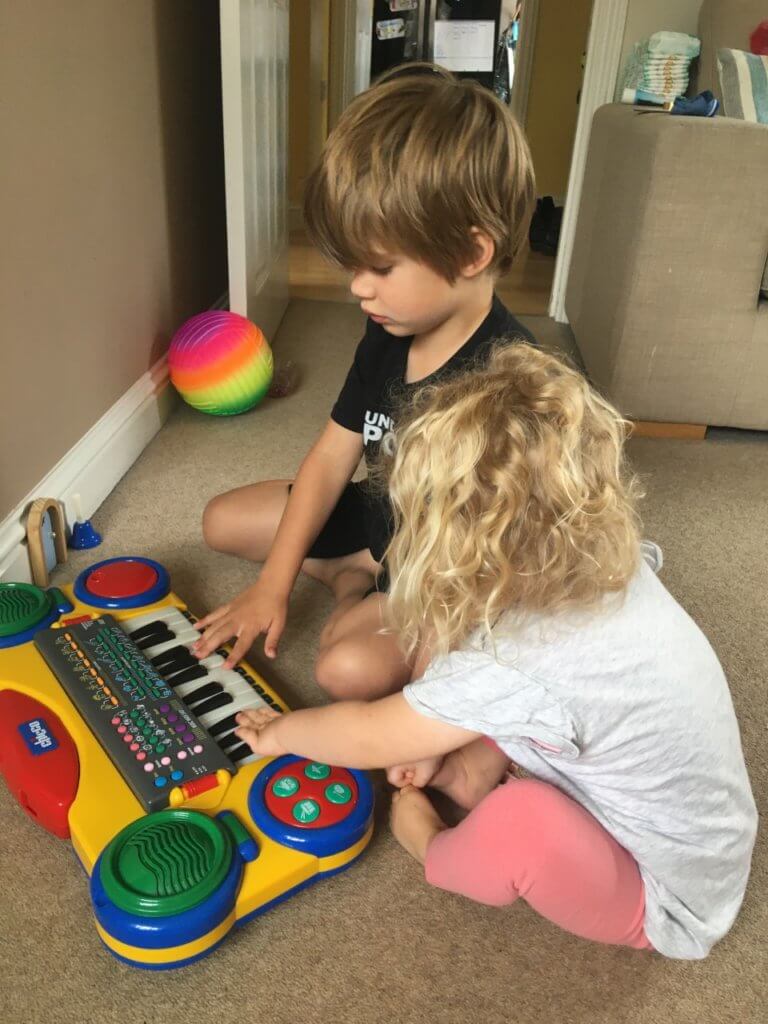
Before trying these exercises, take a minute to physically prepare your child. To wake up their muscles, squeeze their hands, the tips of their fingers and their arms. You could also use a brush along their skin, or a vibrating massager. All of these can help to make a child more aware of their bodies, which can then help them be more accurate and learn more effectively.
Make sure your child is successful in their game as this will motivate them to continue. As you push them to get to the next level, they should be able to manage a few of their attempts to stay motivated.
Remember to praise the effort rather than the result to motivate them to keep putting in effort and not be put off if they don’t succeed.
24 Hand-Eye Coordination Games to try at Home
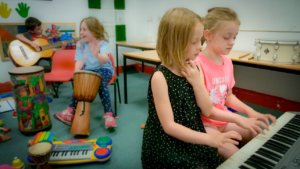
Beating a drum, hitting a bell or hitting notes on a keyboard all require hand-eye coordination.
If you don’t have any instruments at home you can use everyday object such as a wooden spoon and upside down saucepan, a plastic bottle with some rice in it as a rattle or silver foil to scrunch.
For other ideas, visit https://www.activityvillage.co.uk/musical-instruments which has some other easy ways you can make musical instruments from everyday objects in the home.
Cut a piece of thick card into the shape of head. Draw a face on it (your child might want to do this). Then your child can use the clothes pegs on the head to make “hair”.
Wrap string around some chair legs and attach pegs to the string for your child to remove.
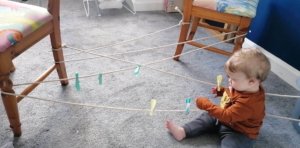
Create a scavenger hunt. Clip pegs around the house on bits of material, paper, drawer handles etc. The child can then go around the house or the room (depending on their mobility) to find the pegs and pinch them off. See this ‘Our Home’ video which shows how to use a tablet to set up a scavenger hunt.
Using home implements can be brilliant for
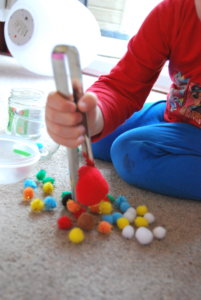 strengthening muscles. For the whole hand use your kitchen or BBQ tongs and get your child to try to pick up bigger items such as socks, soft toys, small cushions.
strengthening muscles. For the whole hand use your kitchen or BBQ tongs and get your child to try to pick up bigger items such as socks, soft toys, small cushions. You could set this up as a scavenger hunt too. Take photos of objects they need to pick up with their tongs from around the home/ room and bring back to the start.
For finger strengthening, use tweezers instead of tongs and pick up small items such as pegs , marbles or beads. See how quickly they can pick up 10 items and put them in a bowl on the other side of the room.
Stack items using fingers, tongs or tweezers (e.g. small blocks, dice)
Use any spare nuts and bolts (and washers) you have around the house to make shapes with card.
Just draw the shape of a dinosaur, snake, tree etc. cut slits or small holes in the card and your child can amuse themselves screwing the nuts and bolts together to make great pieces of 3D art.
Using scissors is a great way to strengthen hands. You can start by cutting dough as this teaches the right way to cut. Make a snake out of dough and ask then to cut it into pieces.
Move on to cutting straight lines on card or paper.
As their skills develop you can be inventive with your cutting and draw interesting shapes for them to cut. These activities should be supervised at all times.
See our video for a great demonstration of making chain Minecraft men with just straight line cutting.
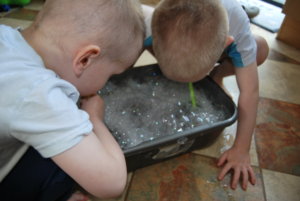 Start by blowing bubbles and catching them with the bubble wand. Bring this closer to your child and ask them to pop it with their hand.
Start by blowing bubbles and catching them with the bubble wand. Bring this closer to your child and ask them to pop it with their hand. Move the wand around so that they are popping in different directions.
Blowing the bubbles into the air close to the child so that they can wave their arms about to pop a bubble.
Move on to blowing fewer bubbles so the child is encouraged to be more accurate with their popping.
-
Roll a ball between you and your child. Start with a big ball and get smaller as your child improves.
Encourage your child to try and stop the ball when it comes to them before rolling back.
Try rolling with more accuracy – e.g. into a upturned container.
Try stopping the ball with two hands
Try stopping the ball with one hand.
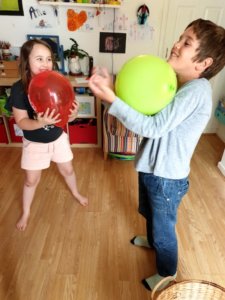
Staying nice and close to each other, roll a balloon to your child and ask them to hit it back. This is great for cause and effect as little effort goes a long way. The balloon moves slowly so your child has more time to aim the hit back.
As your child improves, stand or sit further apart and launch the balloon into the air rather than along the floor.
-
Set up a wobble board for the hands using a tray and a bottle or rolling pin.
-
This video shows you how to play a great hand-eye coordination game.
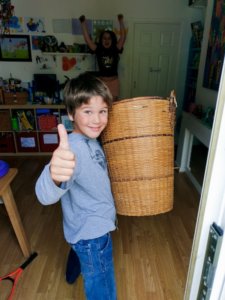
Use a beanbag or soft toy to practice throwing. Start with a big container or target very close to your child.
As your child gets more accurate, move the container further away.
You could encourage your child throw different items into different containers. This could be sorted by colour (e.g. green toys into the bucket, red toys into the laundry basket), or another category (e.g. dinosaurs through the hoop, farm animals into the saucepan).
Set up a Ten-pin bowling set with empty plastic bottles or stack a pyramid of empty tins.
Start very close to the target.
Give your child a large soft ball or soft toy to throw.
Encourage them to get more accurate by seeing how many throws it takes to knock them all over.
As your child gets more accurate, move the target further away.
You can also use a points system in a target game. Draw a target on some cardboard, put a points value on the different section and fix it to the door or on the floor. Encourage your child to throw a ball/toy at it and see how many points they can score in five throws. Then see if they can beat their school.
To make the game more challenging, use post-it notes as targets. Put a number of points on each post-it and stick them to the wall – the higher and smaller the post-it target, the higher the points value. This offers a good maths challenge for the child too.
You could also put letters on the targets and ask your child to spell out a word. This is great way to work on literacy or practice spellings!
Boccia is a fantastic team game that you can play anywhere! The aim of the game is to throw your team’s ball nearest to a target ball. It can be played with as few as two people and from a wheelchair. If balls aren’t available, use rolled up socks.
See our video for a run-through of this very inclusive game.
Give your child a bucket. This could rest on the floor or be held in their arms.
Throw a beanbag or other soft toy into the air and they need to move the bucket to catch it.
As they get better, make the bucket or container smaller so they have to increase their accuracy.
You could also use a smaller or harder for ball for an extra challenge.
Start with a big soft ball and standing/ sitting very close together. Roll the ball into the child’s hands so they get used to holding it and balancing the ball between two hands.
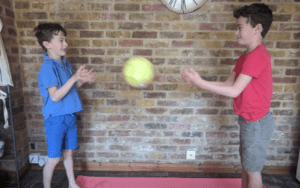
Ask the child to throw it back and keep practising until they are accurate to you at a very small distance.
Start moving back a little so there is a gap between you.
Start making the ball a bit smaller-soft balls and beanbags are easier to catch than fully inflated balls. If you don’t have balls at home use rolled up socks, small cushions or soft toys.
Move onto large inflated balls such as footballs and then try with smaller balls
Progress from two handed catches onto one handed catches
Try also catching on their own: throwing into the air or against a wall.
Try moving further apart from each other one step at a time to increase the challenge. If you are feeling brave try this outside with water balloons.
Trapping the ball/ toy/ beanbag, in the elbow, under the chin, between the shoulder and cheek, under the arm or behind the knee and then letting go can be fun. Try to move the object between body parts. This video demonstrates this unique way of juggling.
Here is a lovely video for more advanced throw and catch against the wall:
Create a ‘Juggle-board‘
-
You can use a flat clothes airer to create a board which enables you and your child to share a adapted ‘juggling’ experience together.
-
To play, rest a ball at one side of the airer, and use your hands to roll it between you and your child. The struts of the airier will act as ‘tracks’ that keep the ball rolling in a straight line.
-
To build the challenge, add another ball, and roll it so that one starts before or after the other. Try rolling the balls at the same time at different speeds.
-
Try sending ball across the board with opposite hands. You could ring a bell or make a sound effect when the ball has reached its destination.
-
Introduce a slow piece of music and try to pass the ball on the beat of 1, 4 or 8. See our video for details of how to set this up.
The progression to this is juggling with just one hand and then eventually juggling with three balls for the ultimate in hand-eye coordination.
You can also watch our ‘Our Home’ video on how to make your own juggling balls.
An egg and spoon race is a great way to challenge hand-eye coordination while multi-tasking. 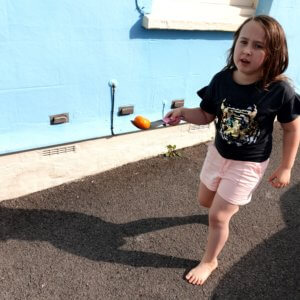
Use a large spoon and a small ball. The child should try to get from A to B without the ball falling of their spoon.
Progress this by putting obstacles in the way. First just aim for the child to walk around an object
Progress to stepping over objects, going backwards or going around the whole house including up and down the stairs (make sure you stay close for safety).
Start with putting soft toys or larger balls into an open container.
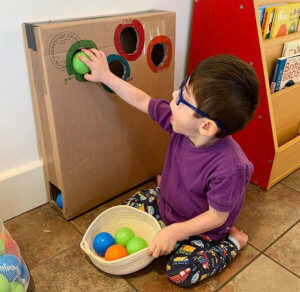
Progress to smaller toys into a smaller container. You could combine this with a matching game: putting the red objects into the red container, blue into blue and so on.
Shape sorter games are fantastic for eye-hand coordination. If you don’t have one, cut a hole in the lid of a plastic pot and post small objects through the hole.
As your child gets more accurate, cut smaller holes or slits and post smaller objects such as coins, pebbles or buttons.
You could cut different sizes of holes so your child has to work out the best one to post their object through.
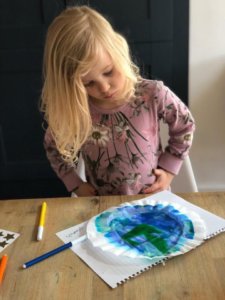
Finger paints are a great ’cause and effect’ way to start to develop hand-eye coordination. Start by painting vertical and horizontal lines, before trying diagonals and lastly circles (which are more complex).
Messy play can offer good opportunity to make trails with fingers, and follow lines. See our messy play recipes for ideas.
When the child is more confident move onto using brushes, crayons or pencils.
Our Fine Motor Skills page has some more ideas for encouraging drawing and painting.
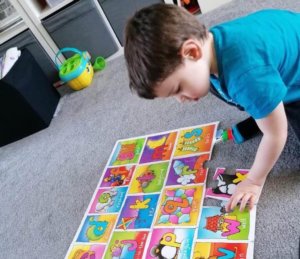
Puzzles are a great way to develop hand-eye coordination. However as some children will try to use force to make a puzzle piece fit, be sure to start with puzzles well within their abilities so you can teach about turning puzzle pieces if necessary. Matching puzzles to ability also reduces chances of frustration, which can be disregulating.
Puzzles with pegs on them are often the best place to start if children don’t have full hand control.
Move onto regular flat puzzles as skills improve.
Use smaller or increased numbers of pieces as skills improve.
If you don’t have puzzles at home, find a good picture from a magazine, perhaps related to a special interest. Cut it into large or smaller pieces which your child can then piece back together.
Any activity that requires connecting parts together will help hand-eye coordination. Connecting toys include Lego, Duplo, K’nex pop toobs, stickle bricks, magformers.
Insert pegs into a pegboard – this can be on a vertical or horizontal surface to increase the challenge. Or your child can sit on a stability ball to challenge their balance and posture.
Marble run toys offer great cause and effect and develop hand-eye coordination skills. If you don’t have access to a toy version you can create your own marble run using pop toobs, or wrapping paper, toilet roll or kitchen roll tubes.
There are some fabulous apps for tablets which require very little movement to get a big effect. Our favourites include:
-
Sensory Lightbox or Sensory Soundbox (£2.99 each, Apple and Android). Just a touch on the screen produces a wide variety of sounds and noises. As you move your fingers/ hand the noises change. Very calming or stimulating, depending on the setting and wonderful feedback for cause and effect.
-
Fluidity HD (free – for Apple devices only) – beautiful flowing colours controlled by any touch on the screen
-
Baby’s Musical hands (free – for Apple and Android) – musical and colourful app – any touch will play a piano sound
-
Finger paint (free for Apple and Android) – opportunity to paint with different colours and sounds, without getting messy.
-
Duck Duck Moose nursery rhymes series (free on Apple and Android). These are a series of apps with entertaining and often surprising cause and effect options which can keep your younger child (and you) entertained for ages. We particularly like Itzy Bitsy HD, Old Mac HD and Trucks HD.
-
Dr Panda series (Apple and Android, vary from free to up to £3.99) has some lovely options with simple yet entertaining games for young children. We enjoy Dr Panda Restaurant, hospital, Beauty Salon and Daycare.






